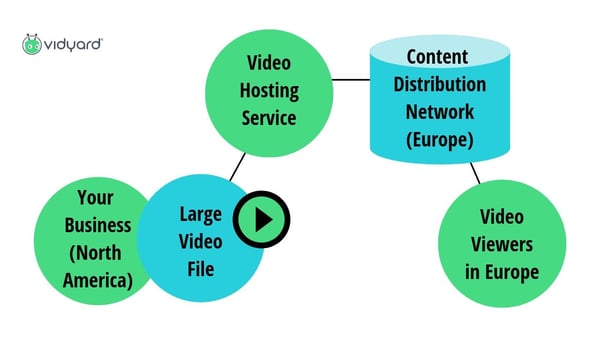September 7, 2023
 by Tyler Lessard / September 7, 2023
by Tyler Lessard / September 7, 2023

Online videos are so ubiquitous today that customers are only shocked when they don’t use them.
If your homepage lacks an explainer video, it leaves visitors clicking the images in confusion, like a toddler trying to swipe pictures in a magazine, thinking it's an iPad.
The lack of explainer videos on the brand website may make your visitors scavenge for video content on the web. Even with a lot of video resources, it might be hard to upload them within content distribution channels due to unsupported file types or playback glitches.
How do you get wonderful videos you spent hours on in front of your audience? By seeking support of third-party video hosting. Media distribution with third-party video hosting software is not only affordable but compatible with registries you can run with local servers easily.
Video hosting helps render, edit, patch, and modify your video files and attach overlays to upload for online audiences. It is an effortless and creative marketing medium that bolsters your engagement with potential prospects and optimizes website conversions.
Video hosting is a digital service where you can upload, edit, and customize your videos so that it is available to your target viewing audience. The service helps you upload and distribute your videos to all third-party streaming platforms for mass audience consumption.
The video-focused social network YouTube is a secure video hosting website: you upload it to one place, and suddenly, it’s available in hundreds of countries.
As we’ll explore, there are many different hosting services, and you have to search carefully for the right one for your business.
So why wouldn’t you host all the videos on your own? For most companies, the answer is it would take too long and cost too much. Video hosting is a bit like dropshipping in e-commerce. Rather than hand-wrap every order yourself, you can send all your inventory to a dropship provider who does it for you. They benefit from economies of scale: they have a warehouse and employees working around the clock.
You can upload your video to a video host that has the infrastructure to distribute it—even in other countries.

The biggest benefit of online video hosting is that it makes your videos available in lots of places while controlling them from one dashboard. That means you get the best experience possible and can distribute them widely while doing less work. That can free you up to create more videos and get even better results.
Here are just some of the benefits of a video hosting platform:
As video grows even more popular, video hosting will become an absolute necessity. Marketers would create video content, which would require platform bandwidth. This platform bandwidth, upload flexibility and watch session benefit would be provided by an online video hosting website.
Ask yourself what your goals are. Are you trying to generate brand awareness? Build pipeline? Convince late-stage buyers? Help your CEO share fireside chats? Help customers answer their own questions? All of the above? As we’ll explain, for each scenario, there is a different platform that’s the best fit for you.
The biggest distinction you should draw between hosting platforms is between those that have a discovery feature, meaning they attract viewers to your video and those that don’t. Both types of platforms have advantages.
YouTube, for instance, has a discovery feature. It’s the second-largest search engine in the world and recommends your videos to people who will enjoy them. That can be great for top-of-funnel marketing, but it also means YouTube could recommend your competitor’s video next.
Pure video hosting solutions without discovery features offer a lot more control, which many businesses need. These platforms will only recommend your videos, allow you to customize the video player, and have deeper analytics.
Ask yourself the following questions to help you make a more informed decision.
If all that matters is reach, video platforms with discovery features are great. If all that matters is personalization and control, a pure video hosting platform works best. For the best of all worlds, use one of each.
Is this for marketing? Sales? Internal communications? Customer success? Everyone? Look at the video hosting platform’s existing customers and use cases—if they don’t have relevant success stories, they may not understand your team’s needs well enough to be helpful.
Make two lists: Necessary Integrations (your marketing automation system, for instance) and those that are nice to have (for example, your CRM). This tells you what your deal-breakers are and helps you narrow the list of options.
Plan a year or two out so you can grow into the platform. The more videos you plan to have, the less likely a free, consumer-grade video hosting platform will work for you. They often lack the organizational features of paid services, and if you can’t easily find and sort your videos, they won’t get used.
Distributing videos within your company is often more complicated than without. Internal messages could contain confidential information, and you may need features to protect them, say, by restricting who can view them. This is especially important for public companies and regulated industries.
There are lots of alternative types of video you might want to consider in the future, like 360 videos (allows the video to look around) and 4K video (super high-definition).
Different players have different strengths. Some offer mobile apps, and others offer flexible browser-based players that work across devices.
If so, you’ll need a video hosting platform with accessibility controls that make it easier to view for those who are blind, color blind, deaf, or require other accommodations. A lot of these changes are made when recording the video, but some players allow you to add subtitles or narration after the fact.
However much support you think you’ll need, double it, especially while onboarding.
The more you need to know about how your videos perform, the more important analytics will be. A video hosting service with advanced analytics can tell you who watched, when, and which parts they rewatched. Platforms that integrate with your customer relationship management (CRM) system or marketing automation platform (MAP) may also be able to score leads based on view time or automate your marketing activities.
Some platforms are free, but the free ones often lack the features businesses need—like tracking video consumption for leads or accounts or the ability to recommend your own videos as opposed to those from your competitors. Know your team’s maximum or “walk-away” number before you evaluate, but also know that most vendors will apply at least some discount.
Be wary of technical configuration, access control, and version compatibility of your videos to ensure a clutter-free experience.
Your video hosting decision will come down to which video hosting platform meets your needs while meeting or falling below your budget. As we’ve discussed, you’ll probably want two video hosting options: A paid platform to organize and track your videos and a free hosting platform that focuses on discovery (i.e. it recommends your videos to viewers).
Both are useful for different things, and neither does it all. Here are specific features to consider:
While all hosting platforms host videos, they charge for different things. In today’s age, bandwidth is a commodity, and you should steer toward vendors that charge based on factors that are more fair, like the number of videos.
Can the platform insert personalized elements based on who the viewer is? Some platforms can insert people’s names or photos into the video, so it appears to have been made just for them.
Does the platform allow you to group, tag, and sort videos? What about creating topic-specific pages or microsites? In short, How easy is it for your team and your customers to find the videos they’re looking for? The better the organization, the more they'll be used, and the better your video ROI.
Does the video hosting solution integrate with your email platform? Will it automatically generate a GIF thumbnail and a link to the video, or do you have to do that yourself?
Every platform offers analytics, but each is tailored to different needs. Hosting platforms that are also social media networks often can’t track individual viewers, and so aren’t very useful to B2B marketing or sales teams. As a rule of thumb, the more specialized the platform, the more useful the analytics. Ask yourself:
If you create an internal company video, can you exclude people outside of your network from watching it? If you restrict it, can you still include partners? With many free hosting services, all videos are publicly available by default.
If you have many people across the organization using the platform, can you give them different levels of access? For instance, can you keep salespeople from accidentally deleting videos? Or success managers from accidentally duplicating them?
Does the platform promote your video to a network? Few do—and most of them are free because, as part of the deal, they allow others to run ads before your video.
Can you create videos within the platform, or do you have to create them with other tools and upload them? (If you can do it all in one platform, it’ll save time.)
In 2019, people watched 1.1 billion hours of live streaming, and it’s likely to keep growing. Lots of social networks are also favoring live-streamed content over other content. Does the platform you’re considering have this capability?

Go slow to go fast. If you jump the gun and trial software only to discover it’s missing the ability to track viewers or doesn’t integrate with your marketing system, this whole process will take a lot longer. You’ll have to download all your videos and reupload them a second time.
The best thing you can do is evaluate carefully. Review all the questions in this article, and ask people on all the teams who’ll be involved. It’s only through questioning that you’ll discover all your needs, like the fact that salespeople want to record, send, and track videos from their phones.
One of the major goals of a sales or marketing cycle is to persuade prospects through enablement. Hosting video content and making it available for the masses would position you as a confident name amid brands that gate content. Thoroughfare explanation, creative marketing, voice assistance, and impactful product visuals can keep you at the forefront of your niche.
Video marketing is the newest type of content strategy across the internet. Learn its sweepstakes in recent days by reading about 40+ video marketing statistics on G2.
Tyler Lessard is a father of four, watcher of Westworld, and creator of exceptional customer experiences. As VP Marketing at Vidyard, he's spent six years immersed in the world of video marketing. He’s a frequent author and speaker on video, content, and demand gen.
Do you know if your videos are resonating with viewers and driving action? Determining the...
 by Divyesh Patel
by Divyesh Patel
The video revolution has been exploding onto the scene for the past few years.
 by Dan Willis
by Dan Willis
Video is one of the best tools marketers and business owners can use to build brand awareness,...
 by Katie Duncan
by Katie Duncan
Do you know if your videos are resonating with viewers and driving action? Determining the...
 by Divyesh Patel
by Divyesh Patel
The video revolution has been exploding onto the scene for the past few years.
 by Dan Willis
by Dan Willis


